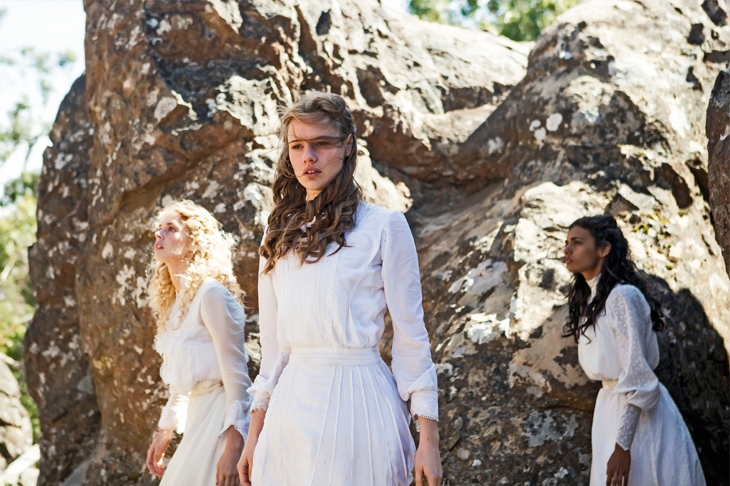According to the opening captions in Picnic at Hanging Rock (BBC2, Wednesday), ‘the infamous events’ it depicts ‘began whena mysterious widow purchased a mansion out in the Australian bush’. The first few scenes, set in the late 19th century, were then dedicated to proving quite how mysterious she was: Hester Appleyard (Natalie Dormer) wasn’t merely veiled, but also filmed largely from behind and — just to be on the safe side — in the dark.
What she might not be, though, is a widow. As she explored her new house, her voice-over dropped a series of dark hints that her mourning dress was a cunning disguise — and that she was in hiding from someone or other after doing somethingor other.
Either way, Mrs Appleyard soon turned the mansion into a girls’ school, which, if anything, allowed her to become even more camply sinister, as she donned some John Lennon specs and urged her charges to embrace purity and refinement. Sadly, in the case of Miranda Reid (Lily Sullivan) she only half-succeeded. Miranda’s rejection of the frankly Weinsteinian advances of a passing soldier certainly passed the purity test — but doing so by stabbing him through the foot with a pitchfork suggested that she might still need to work on her refinement.
Miranda is one of a trio of rebellious seniors whose emerging sexuality was efficiently established by the fact that almost everybody they met — teachers, younger pupils, local menfolk — became immediately smitten. And with that, it was time for the infamous events to unfold. On Valentine’s Day 1900, Mrs Appleyard sent the staff and pupils on a picnic, while she stayed behind to torture an orphan. ‘The area is renowned for its venomous snakes and poisonous spiders,’ she told them by way of a pep talk. ‘Try and have a pleasant day.’
Once they arrived at Hanging Rock, however, snakes and spiders were the least of their worries, what with most of the girls suddenly falling into a deep sleep and time apparently standing still. And that was before the three rebels and a teacher climbed the rock and disappeared.
This new adaptation advertises itself asa ‘reimagining’ of Joan Lindsay’s 1967 novel rather than a remake of Peter Weir’s 1975 film, although it’s kept the pretence of both that it’s based on a true story. Of course, such reimagining partly takes the form of ticking as many 21st-century boxes as possible, including feminism, healthy homosexuality and anti-racism. (One of the trio is Jewish and another half-Aborigine.) But it also means a much bigger role for Mrs Appleyard — hence, presumably, Natalie Dormer’s involvement — and an attempt to intertwine her secrets with whatever happened to the girls.
Whether the programme can pull this off remains to be seen, but the early signs are that it’s struggling to decide between psychological realism, full-on supernaturalism or something more symbolic and dream-like. Alternatively, it might just be hoping that its beautiful cinematography will sweep us along so effectively that we don’t worry too much whether the whole thing is making a great deal of sense. Nonetheless, in its rather po-faced way, Wednesday’s episode was intriguing enough to suggest that it might be worth sticking around to find out.
Unexpectedly for a business documentary, The Rise and Fall of Nokia (BBC4, Tuesday) was also pretty dream-like — not least for most of the participants, who reflected wonderingly on their time working for a Finnish company, founded in 1865 and based in the small town of Salo, that was for 14 years the world’s biggest manufacturer of mobile phones. ‘Looking back,’ said one, ‘it seems like a fairy tale.’
The designers, engineers and entrepreneurs responsible explained with understandable pride how it was done. More sheepishly, they also explained what went wrong — at which point the fairy tale turned into more of a parable. Once the big money rolled in, the company’s cheerful family feel (which, fans of national stereotypes will be pleased to hear, included lots of shared saunas) was replaced with an atmosphere of cold corporatism. Meanwhile, world domination led to hubris — so that when, in 2002, one designer came up with a fully touchscreen phone, Nokia couldn’t see how that improved on its existing products and turned it down.
Nevertheless, the company remained the market leader right up until 9 January 2007, a date that can be given with some precision because the following day Steve Jobs launched the iPhone. (‘Oh yeah,’ was one Nokia designer’s instant response. ‘That’s how it’s supposed to be done.’)
Nokia did soldier on for a bit, but in 2013 sold its mobile-phone division to Microsoft, leaving Salo as something of a ghost town — where, from what we saw, the prevailing mood is now a combination of anxiety, resignation and an increasing disbelief that it was ever a centre of global technology at all.






Comments